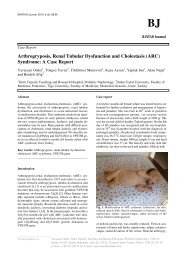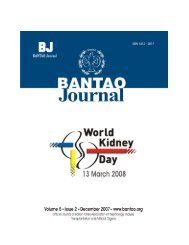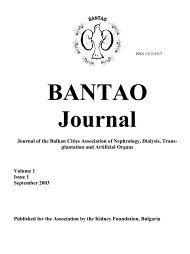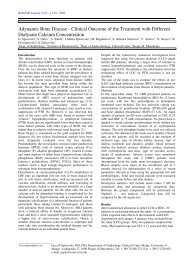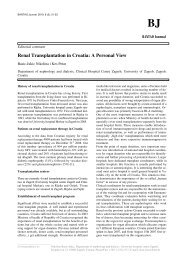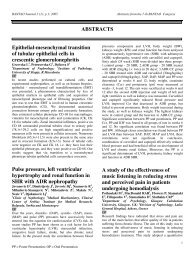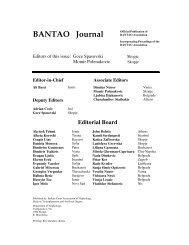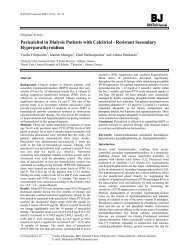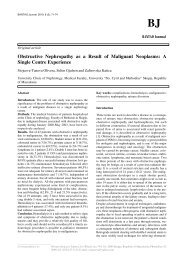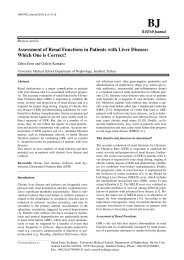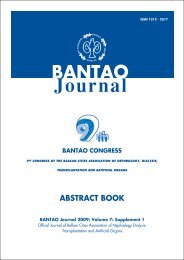Liver and kidney damage in acute poisonings - BANTAO Journal
Liver and kidney damage in acute poisonings - BANTAO Journal
Liver and kidney damage in acute poisonings - BANTAO Journal
Create successful ePaper yourself
Turn your PDF publications into a flip-book with our unique Google optimized e-Paper software.
<strong>BANTAO</strong> <strong>Journal</strong> 2006: 4 (1): 30<br />
<strong>Liver</strong> <strong>and</strong> <strong>kidney</strong> <strong>damage</strong> <strong>in</strong> <strong>acute</strong> poison<strong>in</strong>gs<br />
M. Mydlik <strong>and</strong> K. Derzsiova<br />
Nephrological Cl<strong>in</strong>ic, Faculty Hospital of L. Pasteur, Kosice, Slovak Republic<br />
Abstract<br />
In the paper the retrospective analysis of simultaneous<br />
<strong>damage</strong> of liver <strong>and</strong> <strong>kidney</strong>s after <strong>acute</strong> carbon tetrachloride<br />
poison<strong>in</strong>g <strong>in</strong> 60 patients, after mushroom poison<strong>in</strong>g (Amanita<br />
phalloides) <strong>in</strong> 81 patients <strong>and</strong> after ethylene glycol poison<strong>in</strong>g<br />
<strong>in</strong> 20 patients from the view of differential diagnosis,<br />
conservative, <strong>in</strong>tra- <strong>and</strong> extracorporeal elim<strong>in</strong>ation therapy is<br />
described. Acute toxic hepatitis with the different degree of<br />
severity was present <strong>in</strong> all patients <strong>and</strong> even <strong>acute</strong> renal<br />
failure was present <strong>in</strong> some patients. After <strong>acute</strong> carbon<br />
tetrachloride poison<strong>in</strong>g <strong>acute</strong> hepatitis developed<br />
approximately simultaneously with the development of <strong>acute</strong><br />
renal failure. After <strong>acute</strong> Amanita phalloides poison<strong>in</strong>g <strong>acute</strong><br />
toxic hepatitis, which was the cause of death <strong>in</strong> liver coma <strong>in</strong><br />
16 patients, quickly developed <strong>in</strong> the foreground of the<br />
cl<strong>in</strong>ical picture. Renal <strong>damage</strong> was less frequent <strong>and</strong> it was<br />
not the cause of death even <strong>in</strong> one patient. After <strong>acute</strong><br />
ethylene glycol poison<strong>in</strong>g <strong>acute</strong> renal failure dom<strong>in</strong>ated with<br />
severe metabolic acidosis, oxaluria <strong>and</strong> leucocytosis, <strong>acute</strong><br />
toxic hepatitis was less severe. After ethylene glycol<br />
poison<strong>in</strong>g 3 patients died <strong>in</strong> the period before the use of the<br />
bicarbonate haemodialysis was possible. Dur<strong>in</strong>g 30 years the<br />
<strong>in</strong>tra- <strong>and</strong> extracorporeal elim<strong>in</strong>ation therapy qualitatively<br />
developed (bicarbonate haemodialysis, haemoperfusion<br />
through active charcoal <strong>and</strong> other sorbents, plasmapheresis,<br />
haemofiltration), which participates to the significant degree<br />
on the recovery <strong>and</strong> improvement of the prognosis of patients<br />
after <strong>acute</strong> poison<strong>in</strong>gs with simultaneous <strong>damage</strong> of liver <strong>and</strong><br />
<strong>kidney</strong>s.<br />
Key words: <strong>acute</strong> poison<strong>in</strong>g, carbon tetrachloride,<br />
mushroom (Amanita phalloides), ethylene glycol, hepatic<br />
<strong>and</strong> renal <strong>damage</strong>, extracorporeal elim<strong>in</strong>ation therapy<br />
Introduction<br />
Simultaneous <strong>damage</strong> of liver <strong>and</strong> <strong>kidney</strong>s <strong>in</strong> <strong>acute</strong> poison<strong>in</strong>g<br />
occurs very often <strong>in</strong> present times (Table 1). This fact is very<br />
important from the diagnostic, differential diagnostic <strong>and</strong><br />
therapeutic po<strong>in</strong>t of view (1-6). Besides that a <strong>damage</strong> of<br />
other organs after <strong>acute</strong> poison<strong>in</strong>g can cause multiorgan<br />
failure <strong>in</strong> patients previously healthy (2,5). This f<strong>in</strong>d<strong>in</strong>g is<br />
very important <strong>in</strong> patients with preced<strong>in</strong>g illness (2,7,8).<br />
The aim of the study was the retrospective analysis of 60<br />
patients after carbon tetrachloride poison<strong>in</strong>g, of 81 patients<br />
after mushroom poison<strong>in</strong>g (Amanita phalloides) <strong>and</strong> of 20<br />
patients after ethylene glycol poison<strong>in</strong>g with the liver <strong>and</strong><br />
<strong>kidney</strong> <strong>damage</strong> from the diagnostic, differential diagnostic,<br />
conservative, <strong>in</strong>tra- <strong>and</strong> extracorporeal elim<strong>in</strong>ation treatment<br />
Table 1. Simultaneous <strong>damage</strong> of liver <strong>and</strong> <strong>kidney</strong>s <strong>in</strong> <strong>acute</strong><br />
poison<strong>in</strong>gs<br />
Acute<br />
Damage of<br />
poison<strong>in</strong>g <strong>Liver</strong> Kidneys<br />
1. Carbon tetrachloride + +<br />
2. Dichlorethane + +<br />
3. Ethylene glycol + +<br />
4. Paraquat, Diquat + +<br />
5. Mushroom + +<br />
(Amanita phalloides)<br />
6. Arsenic hydride + +<br />
7. Mercury chloride - +<br />
8. Trichloroethylene + -+<br />
9. Paracetamol + -+<br />
10. Carbamazep<strong>in</strong>e -+ -<br />
11. Isoniazid + -<br />
12. Other -+ -+<br />
Patients <strong>and</strong> Methods<br />
Sixty men, mean age was 41±9 years, after carbon<br />
tetrachloride poison<strong>in</strong>g were <strong>in</strong>vestigated. Among them 52<br />
patients were poisoned by <strong>in</strong>halation way <strong>and</strong> 8 patients<br />
drunk carbon tetrachloride <strong>in</strong> mistake of other dr<strong>in</strong>ks. At the<br />
beg<strong>in</strong>n<strong>in</strong>g of <strong>acute</strong> poison<strong>in</strong>g dyspeptic syndrome was<br />
dom<strong>in</strong>ated, especially after oral poison<strong>in</strong>g. All patients used<br />
ethylalcohol for „the treatment of <strong>acute</strong> dyspepsia“. Use of<br />
ethylalcohol potentiated carbon tetrachloride poison<strong>in</strong>g<br />
(2,7,8). Cl<strong>in</strong>ical <strong>and</strong> laboratory signs after <strong>acute</strong> carbon<br />
tetrachloride poison<strong>in</strong>g from liver <strong>damage</strong> were present<br />
earlier ( several hours or days) <strong>in</strong> comparison to the signs of<br />
<strong>kidney</strong> <strong>damage</strong>. From that reason one third of poisoned<br />
patients was admitted to the Cl<strong>in</strong>ic for Infection Diseases <strong>in</strong><br />
Faculty Hospital, Košice or to the other Departments of<br />
Infection Diseases <strong>in</strong> Eastern Slovakian region. That<br />
diagnostic mistake was caused by <strong>in</strong>sufficient anamnesis,<br />
m<strong>in</strong>imization of the contact with carbon tetrachloride by<br />
patients or deliberate concealment of the contact with that<br />
poison. Carbon tetrachloride is a very good lipid solvent <strong>and</strong><br />
<strong>in</strong> the past it was used <strong>in</strong> home sett<strong>in</strong>g <strong>and</strong> <strong>in</strong> many<br />
workplaces (1,7,8). Except this carbon tetrachloride was<br />
used as a fill<strong>in</strong>g <strong>in</strong> fire-ext<strong>in</strong>guishers (2).<br />
Eighty-one patients were <strong>in</strong>vestigated after mushroom<br />
poison<strong>in</strong>g (Amanita phalloides), mean age was 30.5±9 years.<br />
Among them were 28 children <strong>and</strong> 53 adult patients. Cl<strong>in</strong>ical<br />
<strong>and</strong> laboratory signs after <strong>acute</strong> poison<strong>in</strong>g of Amanita<br />
phalloides were present first of all dur<strong>in</strong>g the several hours as<br />
an <strong>acute</strong> dyspepsia with the rapid <strong>in</strong>crease of serum bilirub<strong>in</strong><br />
<strong>and</strong> of activity of serum transam<strong>in</strong>ases. Acute renal failure<br />
developed later or was not present. All <strong>acute</strong> poison<strong>in</strong>g<br />
caused by Amanita phalloides were accidental except one<br />
po<strong>in</strong>t of view.<br />
______________________<br />
Correspondence to: M. Mydlik, Nephrological Cl<strong>in</strong>ic, Faculty Hospital of<br />
L. Pasteur, Rastislavova 43, 041 90 Košice, Slovak Republic; E-mail: k.derzsiova@ fnlp.sk
<strong>BANTAO</strong> <strong>Journal</strong> 2006: 4 (1): 31<br />
young lady, who ate Amanita phalloides <strong>in</strong> attempted suicide<br />
(3,9,10).<br />
The third group of patients were 20 patients after ethylene<br />
glycol poison<strong>in</strong>g. Mean age was 41± 8 years, among them<br />
were 2 women <strong>and</strong> 18 men. Ethylene glycol was the most<br />
frequent oral poison<strong>in</strong>g <strong>in</strong> a form of antifreeze agent which<br />
was used <strong>in</strong> the cars. That poison was used frequently <strong>in</strong> the<br />
change for ethylalcohol or from „ absence of ethylalcohol<br />
dr<strong>in</strong>ks“ <strong>in</strong> three soldiers. Ethylene glycol is a very dangerous<br />
poison<strong>in</strong>g nowadays <strong>and</strong> it is relatively frequent <strong>in</strong> our<br />
country <strong>in</strong> present times (3,5,6,11,12).<br />
In three groups of patients with those poison<strong>in</strong>gs all available<br />
diagnostic <strong>and</strong> therapeutic methods were used <strong>in</strong>clud<strong>in</strong>g<br />
various forms of <strong>in</strong>tra-<strong>and</strong> extracorporeal elim<strong>in</strong>ation<br />
methods (1-8,10-16). In the treatment of carbon tetrachloride<br />
poison<strong>in</strong>g we did not use a hyperbaric oxygen therapy (17).<br />
Results<br />
Cl<strong>in</strong>ical signs <strong>and</strong> some laboratory parameters, conservative<br />
<strong>and</strong> <strong>in</strong>tra-<strong>and</strong> extracorporeal elim<strong>in</strong>ation treatment <strong>in</strong> the<br />
patients after carbon tetrachloride, mushroom (Amanita<br />
phalloides) <strong>and</strong> ethylene glycol poison<strong>in</strong>gs were described <strong>in</strong><br />
Tables 2-4.<br />
Table 2. <strong>Liver</strong> <strong>damage</strong> <strong>in</strong> <strong>acute</strong> poison<strong>in</strong>g<br />
Poison<strong>in</strong>g Number of Hepatomegaly Bi Serum AST Coma<br />
patients<br />
(µmol/L) ALT (µkat/L)<br />
1. Carbon tetrachloride 60 57 78.4±20.5 16.2±3.3 - 4<br />
2. Mushroom<br />
81 81 76.8±14.1 89.5±12.4 88.7±12.8 16<br />
(Amanita phalloides)<br />
3. Ethylene glycol 20 16 17.5± 2.0 1.23± 0.45 1.12±0.4 5<br />
Bi-bilirub<strong>in</strong><br />
Table 3. Kidney <strong>damage</strong> <strong>in</strong> <strong>acute</strong> poison<strong>in</strong>g<br />
Poison<strong>in</strong>g Number of<br />
patients<br />
Prote<strong>in</strong>uria<br />
(g/24h)<br />
K<br />
(mmol/L)<br />
Serum<br />
Urea<br />
Creat<strong>in</strong><strong>in</strong>e<br />
(µmol/L)<br />
Metabolic<br />
acidosis (pH)<br />
1. Carbon tetrachloride 60 57 78.4±20.5 16.2±3.3 - 4<br />
2. Mushroom<br />
81 81 76.8±14.1 89.5±12.4 88.7±12.8 16<br />
(Amanita phalloides)<br />
3. Ethylene glycol 20 16 17.5± 2.0 1.23± 0.45 1.12±0.4 5<br />
Table 4. Intra-<strong>and</strong> extracorporeal elim<strong>in</strong>ation therapy <strong>in</strong> <strong>acute</strong> poison<strong>in</strong>g<br />
Poison<strong>in</strong>g<br />
Number of Intra-<strong>and</strong> extracorporeal elim<strong>in</strong>ation therapy<br />
patients PD HD ET HP PF<br />
Mortality<br />
1. Carbon tetrachloride 60 8 81 6 - 4 2 (3.3%)<br />
2. Mushroom<br />
81 - 20 2 128 23 24 (29.6%)<br />
(Amanita phalloides)<br />
3. Ethylene glycol 20 - 28Ac+147Bic - 5 - 3 (15%)<br />
PD-peritoneal dialysis, HD-haemodialysis, Ac-acetate, Bic-bicarbonate, ET-exchange transfuzion,<br />
HP-haemoperfusion, PF-plasmapheresis<br />
Discussion<br />
In differential diagnosis of the patients with simultaneous<br />
<strong>damage</strong> of the liver <strong>and</strong> <strong>kidney</strong>s, a direct anamnesis of<br />
patients is very important, but also an <strong>in</strong>direct anamnesis<br />
from family members or from co-workers. It is necessary to<br />
dist<strong>in</strong>guish <strong>acute</strong> viral hepatitis from <strong>acute</strong> carbon<br />
tetrachloride poison<strong>in</strong>g, from poison<strong>in</strong>g by dichloroethane,<br />
mushroom poison<strong>in</strong>g (Amanita phalloides), arsenic hydride,<br />
ethylene glycol <strong>and</strong> from <strong>acute</strong> leptospirosis (1-3, 5,6,8-<br />
10,12,16,18). After <strong>acute</strong> paraquat poison<strong>in</strong>g <strong>and</strong><br />
simultaneously with a <strong>damage</strong> of the liver <strong>and</strong> <strong>kidney</strong>s,<br />
the <strong>damage</strong> of lung <strong>and</strong> heart is developed. The patient who<br />
is <strong>in</strong>sufficiently treated after paraquat poison<strong>in</strong>g is dy<strong>in</strong>g<br />
dur<strong>in</strong>g the follow<strong>in</strong>g 10-14 days. Cause of death after that<br />
poison<strong>in</strong>g is alveolocapillary block <strong>in</strong> the lung (19,20). Acute<br />
arsenic hydride poison<strong>in</strong>g <strong>in</strong> our department was not present<br />
dur<strong>in</strong>g the last 35 years (5,21-23). Acute mercury chloride<br />
poison<strong>in</strong>g leads to <strong>acute</strong> renal failure without liver <strong>damage</strong><br />
(5). Acute trichloroethylene poison<strong>in</strong>g is manifested by<br />
cerebral <strong>and</strong> liver <strong>damage</strong>. Damage of the <strong>kidney</strong>s is very<br />
rare but it was described (24). Acute paracetamol poison<strong>in</strong>g<br />
leads to liver <strong>damage</strong>, but <strong>kidney</strong> <strong>damage</strong> <strong>in</strong> some patients<br />
was also described (25-27). After oral carbamazep<strong>in</strong>e<br />
poison<strong>in</strong>g important liver <strong>damage</strong> was observed (28). <strong>Liver</strong><br />
<strong>damage</strong> after isoniazid poison<strong>in</strong>g was also observed. High<br />
<strong>in</strong>travenous dose of pyridox<strong>in</strong>e (5g/24 h) as an antidote <strong>in</strong><br />
that poison<strong>in</strong>g was recommended (5). We successfully used<br />
this therapy <strong>in</strong> one our patient after severe isoniazid<br />
poison<strong>in</strong>g.<br />
Acute toxic hepatitis dom<strong>in</strong>ated <strong>in</strong> the first group of patients<br />
who were poisoned by carbon tetrachloride, <strong>in</strong> four of them<br />
developed liver coma. Two patients suffer<strong>in</strong>g from preced<strong>in</strong>g<br />
chronic hepatitis died <strong>in</strong> liver coma despite of the use of<br />
repeated haemodialyses <strong>and</strong> exchange transfusions.<br />
Anamnestic serum titres aga<strong>in</strong>st Leptospira grippotyphosa<br />
were found <strong>in</strong> one patient suffer<strong>in</strong>g from <strong>acute</strong> carbon<br />
tetrachloride poison<strong>in</strong>g <strong>and</strong> <strong>in</strong> another patient with the same<br />
poison<strong>in</strong>g <strong>acute</strong> leptospirosis developed caused by Leptospira<br />
sejr. Dynamics of titres testified to <strong>acute</strong> illness (2).<br />
Determ<strong>in</strong>ation of serum titres aga<strong>in</strong>st leptospirosis was very<br />
important especially <strong>in</strong> the patients from agricultural region.<br />
Uremic syndrome as a sign of <strong>acute</strong> renal failure <strong>in</strong> <strong>acute</strong><br />
carbon tetrachloride poison<strong>in</strong>g developed relatively slowly <strong>in</strong><br />
comparison to other <strong>acute</strong> poison<strong>in</strong>gs (2). Duration of <strong>acute</strong><br />
carbon tetrachloride poison<strong>in</strong>g until to restore to normal of<br />
hepatic tests <strong>and</strong> of renal functions was <strong>in</strong> average 39±9 days.<br />
The treatment of carbon tetrachloride poison<strong>in</strong>g <strong>in</strong>cluded: use
<strong>BANTAO</strong> <strong>Journal</strong> 2006: 4 (1): 32<br />
of hepatotropic drugs, forced diuresis, repeated<br />
haemodialyses, peritoneal dialysis <strong>and</strong> <strong>in</strong> patients <strong>in</strong> liver<br />
coma we used exchange transfusions <strong>and</strong> later<br />
plasmaphereses (2,8). Occurrence of <strong>acute</strong> tetrachloride<br />
poison<strong>in</strong>g is very rare <strong>in</strong> the last years, because it was due to<br />
prohibition to use of carbon tetrachloride <strong>in</strong> fireext<strong>in</strong>guishers,<br />
<strong>in</strong> <strong>in</strong>dustry <strong>and</strong> <strong>in</strong> various chemical<br />
laboratories.<br />
In the second group of 81 patients, who were poisoned by<br />
mushroom (Amanita phalloides), <strong>acute</strong> toxic hepatitis<br />
developed rapidly until to liver <strong>in</strong>sufficiency <strong>and</strong> coma. From<br />
this group of patients 24 patients (29,6%) died <strong>in</strong> liver coma.<br />
Damage of the <strong>kidney</strong>s after Amanita phalloides poison<strong>in</strong>g<br />
was less frequent, despite that <strong>in</strong> 16 patients <strong>acute</strong> tubular<br />
necrosis with <strong>kidney</strong> failure developed. No one patient died<br />
caused by <strong>acute</strong> renal failure. That dissociation of liver <strong>and</strong><br />
<strong>kidney</strong> <strong>damage</strong> is characteristic for hepatotoxic type of <strong>acute</strong><br />
mushroom poison<strong>in</strong>g. Conservative treatment <strong>in</strong>clud<strong>in</strong>g of<br />
hepatic drugs <strong>and</strong> of forced diuresis <strong>and</strong> especially of<br />
extracorporeal elim<strong>in</strong>ation therapy we used relatively late for<br />
the late admission of the patients to our renal unit (<strong>in</strong> average<br />
53 hours after poison<strong>in</strong>g).<br />
Dur<strong>in</strong>g many years we tried to use early haemodialysis,<br />
charcoal haemoperfusion, Amberlite XAD-2 <strong>and</strong> XAD-4<br />
haemoperfusions <strong>and</strong> <strong>in</strong> the last years plasmapheresis which<br />
is the bridge to liver transplantation. Haemodialysis was used<br />
on the <strong>in</strong>fluence of uremic syndrome (3,5,9,10,13,14).<br />
In the third group of patients with <strong>acute</strong> ethylene glycol<br />
poison<strong>in</strong>g dom<strong>in</strong>ated severe metabolic acidosis, leucocytosis,<br />
oxaluria <strong>and</strong> various neurological symptoms. Leucocytosis<br />
was present from the onset of <strong>acute</strong> poison<strong>in</strong>g caused by<br />
ethylene glycol irritation of the bone marrow <strong>and</strong> duration of<br />
that laboratory sign was <strong>in</strong> average 7 days. Damage of the<br />
<strong>kidney</strong>s with relatively slow development of <strong>acute</strong> renal<br />
failure showed for the important disturbances of renal<br />
functions. Damage of the liver with hepatomegaly <strong>and</strong><br />
<strong>in</strong>crease of serum activity of alan<strong>in</strong>e am<strong>in</strong>otransferase were<br />
less important <strong>and</strong> occurred <strong>in</strong> 16 patients (11,12).<br />
Dissociation of the liver <strong>and</strong> <strong>kidney</strong> <strong>damage</strong> was present after<br />
ethylene glycol poison<strong>in</strong>g <strong>in</strong> disadvantage for the <strong>kidney</strong><br />
<strong>damage</strong>. In the medical treatment of ethylene glycol<br />
poison<strong>in</strong>g were applicated hepatic drugs <strong>in</strong>clud<strong>in</strong>g of the<br />
group of vitam<strong>in</strong> B. The therapeutic method of choice <strong>in</strong><br />
ethylene glycol poison<strong>in</strong>g was <strong>in</strong> the last years bicarbonate<br />
haemodialysis us<strong>in</strong>g 100 mg% ethylalcohol <strong>in</strong> dialysis<br />
solution. Ethylalcohol was used as a blocker of<br />
alcoholdehydrogenase <strong>in</strong> metabolic transformation from<br />
ethylene glycol to glycol aldehyde. Two patients died after<br />
ethylene glycol poison<strong>in</strong>g before the possibility to use<br />
bicarbonate haemodialysis <strong>and</strong> one patient died for the late<br />
admission to our dialysis unit (11,12).<br />
At the end of this retrospective study it is neccessary to say,<br />
that the review of simultaneous <strong>damage</strong> of the liver <strong>and</strong><br />
<strong>kidney</strong>s after carbon tetrachloride poison<strong>in</strong>g, mushroom<br />
poison<strong>in</strong>g (Amanita phalloides) <strong>and</strong> ethylene glycol<br />
poison<strong>in</strong>g contributed to diagnosis, differential diagnosis <strong>and</strong><br />
also to the use of various forms of extracorporeal elim<strong>in</strong>ation<br />
therapy. In the near future several new forms of<br />
extracorporeal elim<strong>in</strong>ation therapy will be used <strong>in</strong> the<br />
treatment of <strong>acute</strong> poison<strong>in</strong>g i.e. album<strong>in</strong> dialysis <strong>and</strong> the use<br />
of new sorbents for tox<strong>in</strong>s removal ma<strong>in</strong>ly for tox<strong>in</strong>s with<br />
high album<strong>in</strong> <strong>and</strong> other prote<strong>in</strong>s b<strong>in</strong>d<strong>in</strong>g <strong>in</strong> plasma (29-31).<br />
References<br />
1. Jaros F. Practical toxicology. 1st eds. Mart<strong>in</strong>: Osveta, 1988;<br />
200 p.<br />
2. Mydlik M, Takac M, Melnicak P et al. Diagnosis <strong>and</strong> therapy<br />
of carbon tetrachloride poisonong. Vnitr Lek 25, 1979; 7: 672-9<br />
3. Mydlik M, Derzsiova K. Use of hemoperfusion <strong>in</strong> <strong>acute</strong><br />
poison<strong>in</strong>g: Cl<strong>in</strong>ical analysis of 229 patients. In: D.<br />
Falkenhagen, H. Kl<strong>in</strong>kmann, E. Pisk<strong>in</strong>, K. Opatrny, Jr. (eds):<br />
Blood-Material Interaction. A basic guide from polymer<br />
science to cl<strong>in</strong>ical application. S 149- S 153. INFA 1998,<br />
Glasgow, Krems, 156 p.<br />
4. Mydlik M, Derzsiova K, Mizla P. Use of plasmapheresis <strong>in</strong><br />
dialysis centre - - analysis of 105 patients. Akt Nefrol 8, 2002;<br />
1: 9-13<br />
5. Seyfart G. Poison Index. The treatment of <strong>acute</strong> <strong>in</strong>toxication.<br />
1st ed. Pubst Science Publisher, Lengerich, Berl<strong>in</strong>, Düsseldorf<br />
et al. 1997; 664 p.<br />
6. Sevcik M. Practical toxicology. IIIrd ed. Státní zdravotnické<br />
nakladatelství, Prague 1968; 350 p.<br />
7. Mydlik M, Halko N. Use of exchange transfusion <strong>in</strong> <strong>acute</strong><br />
poison<strong>in</strong>gs. Prakt Lék 59, 1979; 22: 846-9<br />
8. Mydlik M, Derzsiova K, Mizla P. Diagnosis <strong>and</strong> treatment of<br />
carbon tetrachloride poison<strong>in</strong>g – analysis of 60 patients.<br />
Abstract of the XIIth International Congress of Nephrology, p.<br />
286. Jerusalem, Israel, 1993; 13-18<br />
9. Mydlik M, Derzsiova K, Mizla P et al. Use of haemoperfusion<br />
<strong>in</strong> <strong>acute</strong> mushroom poison<strong>in</strong>g. Cl<strong>in</strong>ical analysis of 58 patients.<br />
Cas Lek Ces 132, 1993; 15: 464-7<br />
10. Mydlik M, Derzsiova K, Klan J et al. Haemoperfusion with<br />
alpha-amanit<strong>in</strong> – an <strong>in</strong> vitro study. Int J Artif Organs 20, 1997;<br />
2: 105-7<br />
11. Mydlik M, Melnicak P, Derzsiova K et al. Dialysis therapy of<br />
<strong>acute</strong> renal failure. Analysis of 230 patients. Cas Lek Ces 118,<br />
1979; 18: 559-63<br />
12. Mydlík M, Derzsiová K, Mizla P et al. Diagnosis <strong>and</strong> therapy<br />
of <strong>acute</strong> ethylene glycol poison<strong>in</strong>g – analysis of 20 patients.<br />
Vnit Lék 48, 2002; 11: 1054-9<br />
13. Enjabert F, Rapior S, Nouguier-Soule J et al. Treatment of<br />
amatox<strong>in</strong> poison<strong>in</strong>g: 20–-year retrospective analysis. J Toxicol<br />
Cl<strong>in</strong> Toxicol 40, 2002; 6: 715-57<br />
14. Galmar<strong>in</strong>i D, Tarenzi L, Cantaluppi P et al. Acute hepatic<br />
failure <strong>and</strong> renal <strong>damage</strong>. Experimental <strong>and</strong> cl<strong>in</strong>ical studies.<br />
M<strong>in</strong>erva Med 30, 1978; 69: 1417-26<br />
15. Markiewicz K, Trznadel K, Szeszko A. Acute carbon<br />
tetrachloride poison<strong>in</strong>g. Med Pr 28, 1977; 1: 15-20<br />
16. Svendsen B S, Gjellestr<strong>and</strong> A, Eiv<strong>in</strong>dson G et al. Serious<br />
mushroom poison<strong>in</strong>g by Cort<strong>in</strong>arius <strong>and</strong> Amanita virosa.<br />
Tidsskr Nor Laegeforen 122, 2002; 8: 777-80<br />
17. Burkhart K K, Hall A H, Gerace R et al. Hyperbaric oxygen<br />
treatment for carbon tetrachloride poison<strong>in</strong>g. Drug Saf 6, 1991;<br />
5: 332-8<br />
18. Nehoda H, Wieser C Koller J et al. Recurrent liver failure with<br />
severe rhabdomyolysis after liver transplantation for carbon<br />
tetrachloride <strong>in</strong>toxication. Hepatogastroenterology 45, 1998;<br />
19: 191-5<br />
19. Fern<strong>and</strong>ez P, Bermejo A M, Lopez-Riv<strong>and</strong>ulla M et al. A fatal<br />
case of parenteral paraquat poison<strong>in</strong>g. Forensic Sci Int 49,<br />
1991; 2:215-24<br />
20. Melnicak P, Mydlik M. Poison<strong>in</strong>g by Gramoxon (paraquat).<br />
Proceed<strong>in</strong>gs of the „Industrial toxicology 78“, Bratislava 21.-<br />
24. VI. 1978, p. 147-57, Zil<strong>in</strong>a, House of Technique SVTS<br />
Žil<strong>in</strong>a – 55/78, 308 p.<br />
21. Labadie H, Stoessel P, Callard P et al. Hepatic venoocclusive<br />
disease <strong>and</strong> peris<strong>in</strong>usoidal fibrosis secondary to arsenic<br />
poison<strong>in</strong>g. Gastroenterology 99, 1990; 4: 1140-43<br />
22. L<strong>in</strong> J M, Jiang CQ. Cl<strong>in</strong>ical manifestation <strong>and</strong> ultrasonic<br />
characteristic of five patients with <strong>acute</strong> arsenic poison<strong>in</strong>g.<br />
Zhonguhua Lao Dong Wei Sheng Zhi Ye B<strong>in</strong>g Za Zhi 21, 2003;<br />
6: 420-2
<strong>BANTAO</strong> <strong>Journal</strong> 2006: 4 (1): 33<br />
23. Mathieu D, Mathieu-Nolf M, Germa<strong>in</strong>-Alonso M et al.<br />
Massive-arsenic poison<strong>in</strong>g--effect of hemodialysis <strong>and</strong><br />
dimercaprol on arsenic k<strong>in</strong>etics. Intensive Care Med 18, 1992;<br />
1: 47-50<br />
24. David NJ, Wolman R, Milne FJ et al. Acute renal failure due to<br />
trichlorethylene poison<strong>in</strong>g. Brit J Ind Med 46, 1989; 5:347-9<br />
25. Derzsiová K, Mydlík M, Petríková V et al. Haemoperfusion of<br />
paracetamol – an <strong>in</strong> vitro study. Akt Nefrol 8, 2002; 4: 129 –32<br />
26. Herrero J L, Castellano I, Gomez-Mart<strong>in</strong>o J R. Acute <strong>kidney</strong><br />
failure caused by paracemol poison<strong>in</strong>g. Nefrologia 21, 2001; 6:<br />
592-5<br />
27. Jones A F, Vale J A. Paracetamol poison<strong>in</strong>g <strong>and</strong> the <strong>kidney</strong>. J<br />
Cl<strong>in</strong> Pharm Ther 18, 1993; 1: 5-8<br />
28. Hopen G, Nesthus I, Laerum OD. Fatal carbamazep<strong>in</strong>associated<br />
hepatitis. Report of two cases. Acta Med Sc<strong>and</strong> 210,<br />
1981; 4: 333-5<br />
29. Sen S, Ytrebo LM, Rose C et al. Album<strong>in</strong> dialysis: a new<br />
therapeutic strategy for <strong>in</strong>toxication from prote<strong>in</strong>-bound drugs.<br />
Intensive Care Med 30, 2000; 3: 496-501<br />
30. Senf R, Kl<strong>in</strong>gel R, Kurz S et al. Bilirub<strong>in</strong>-adsorption <strong>in</strong> 33<br />
critically ill patients with liver failure. Int J Artif Organs 27,<br />
2004; 8: 717-22<br />
31. Wu BF, Wang MM. Molecular adsorbent recirculat<strong>in</strong>g system<br />
<strong>in</strong> deal<strong>in</strong>g with maternal Amanita poison<strong>in</strong>g dur<strong>in</strong>g the second<br />
pregnancy trimester: a case report. Hepatobiliary Pancreat Dis<br />
Int 3, 2004; 1: 152-4



